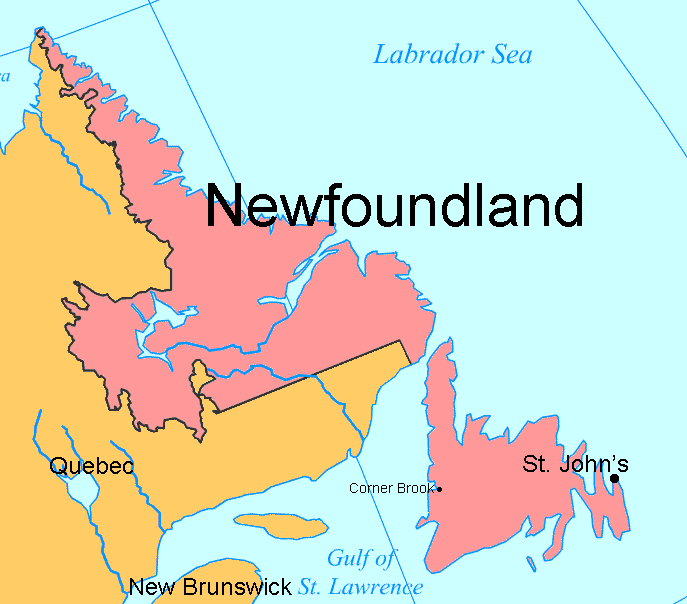|
Newfoundland
Newfoundland and Labrador (French, Terre-Neuve-et-Labrador, Irish: Talamh an Éisc, Latin: Terra Nova) was the tenth province to join the Canadian confederation. Its capital is St. John's. The province's population is 533,800. People from Newfoundland are called "Newfoundlanders" (and at times "Newfies", though this can be derogatory) while people from Labrador are called "Labradorians". Newfoundland has its own dialect of English. Newfoundland French is near extinction as is Newfoundland Irish. The oldest known settlement anywhere in The Americas built by Europeans is located at L'Anse aux Meadows, Newfoundland, founded circa 1000 A.D. by Leif Ericson's Vikings. John Guy was governor of the first colony, Cuper's Cove. Newfoundland received a colonial assembly in 1832, which was and still is referred to as the House of Assembly, after a fight led by reformers William Carson, Patrick Morris and John Kent. In 1854, Newfoundland was granted responsible government by the British government. In 1855, Philip Francis Little, a native of Prince Edward Island, won a majority over Sir Hugh Hoyles and the Conservatives. Little formed the first administration from 1855 to 1858. Newfoundland rejected confederation with Canada in the 1869 general election. It remained as a colony until acquiring dominion status in 1907 along with New Zealand. It attempted to reach a trade agreement with the United States but failed. The Dominion of Newfoundland reached its golden age under the premiership of Sir Robert Bond of the Liberal Party. In the 1920s, political scandals wracked the dominion. In 1923, Prime Minister Sir Richard Squires was arrested on charges of corruption. He was released soon after on bail, but the scandal was reviewed by the British-led Hollis Walker commission. Soon after, the Squires government fell. Squires returned to power in 1928 only to control a country suffering from the Great Depression. A referendum on July 22, 1948, which asked Newfoundlanders to choose between confederation and dominion status, was decided by a vote of 52% to 48% for confederation with Canada. Newfoundland joined Canada on March 31, 1949. Not everyone was satisfied with the results, however. Cashin, an outspoken anti-Confederate, questioned the validity of the votes. He claimed that it was the 'unholy union between London and Ottawa' that brought about confederation. In 1996, the former federal minister of fisheries, Brian Tobin, was successful in winning the leadership of the provincial Liberal Party following the retirement of premier Clyde Wells. Tobin rode the waves of economic good fortune as the downtrodden provincial economy was undergoing a fundamental shift, largely as a result of the oil and gas industry's financial stimulus, although the effects of this were mainly felt only in communities on the Avalon Peninsula. Good fortune also fell on Tobin following the discovery of some of the world's largest nickel deposits at Voisey's Bay. Tobin committed to negotiating a better royalty deal for the province with private sector mining interests than previous governments had done with the Churchill Falls hydroelectric development deal in the 1970s. Following Tobin's return to federal politics in 2000, the provincial Liberal Party devolved into internal battling for the leadership, leaving its new leader, Roger Grimes, in a weakened position as premier. The pressure of the oil and gas industry to explore offshore in Atlantic Canada saw Newfoundland and Nova Scotia submit to a federal arbitration to decide on a disputed offshore boundary between the two provinces in the Laurentian Basin. The 2003 settlement rewrote an existing boundary in Newfoundland's favour, opening this area up to energy exploration. In 2003, the federal government declared a moratorium on the last remaining cod fishery in Atlantic Canada - in the Gulf of St. Lawrence. While Newfoundland was again the most directly affected province by this decision, communities on Quebec's North Shore and in other parts of Atlantic Canada also faced difficulties. From late October 2004 to the present, Premier Williams has argued that Prime Minister Paul Martin has not held up his promises for a new deal on the "Atlantic Accord". The issue is the royalties from oil: currently, 70 cents on each royalty dollar are sent back to the federal government through reductions in payments by the federal government with respect to its "equalization program". The province wants 100% of the royalties to allow the province to pull itself out of poverty on a long-term basis. Toward the end of 2004, Williams ordered the Canadian flag to be removed from all provincial buildings as a protest against federal policies, and asked for municipal councils to consider doing the same. The issue, dubbed the "Flag Flap" in the media, sparked debate across the province and the rest of Canada. The flags went back up in January 2005 after much controversy nationwide and Paul Martin stating that he would not negotiate with the province if the flags were not flying. At the end of January, the federal government signed a deal to allow 100% of oil revenues to go to the province, resulting in an extra $2 billion over eight years for the province. However, this agreement has led other provinces such as Ontario and Quebec to try to negotiate their own special deals as they too claim that the federal government is taking advantage of them financially. |
||||||||||
